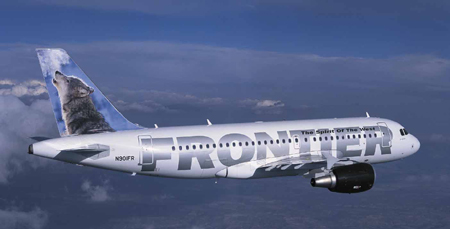David Field / Washington
Frontier Airlines' front man Jeff Potter is still smiling, despite stiff competition from low-cost carrier Southwest
 There is no reason whatsoever for this man to smile. In fact, a casual observer might well think that Jeff Potter, the chief executive of Frontier Airlines, would be grim faced, with his palm stretched out for aid. Consider: Frontier has always played distant second to giant United at its Denver home base, competing bravely on price and on the fact that it knows what people want because it wants to be the hometown airline. United’s been through the wringer, still taking baby steps after coming out of its three-year reorganisation early this year, and Frontier may have benefited from that, but United is an airline in recovery, not decline.
There is no reason whatsoever for this man to smile. In fact, a casual observer might well think that Jeff Potter, the chief executive of Frontier Airlines, would be grim faced, with his palm stretched out for aid. Consider: Frontier has always played distant second to giant United at its Denver home base, competing bravely on price and on the fact that it knows what people want because it wants to be the hometown airline. United’s been through the wringer, still taking baby steps after coming out of its three-year reorganisation early this year, and Frontier may have benefited from that, but United is an airline in recovery, not decline.
The Mile High City, as the hub of the Rocky Mountains is known, has a new kid in town, and that kid is no baby. We’re talking about Southwest of course, which began Denver International Airport service in January with a handful of flights and, as Southwest usually does, has grown rapidly.
Unfazed
Frontier's Potter came to Washington this week to tell folks he’s unfazed. Competing against Southwest is no easy thing, and Potter says Frontier probably didn’t adapt as quickly as it should have, but “we are now finally seeing the results that we expected”. He says that “We didn't see the improvement as early as we had hoped”, but that Frontier has seen traffic and yield increase in April on two of the five routes against which it competes head-to-head with Southwest, following double-digit unit revenue declines on the five routes during the quarter that ended 31 March. For the fiscal year that also ended with that quarter, Frontier lost $14 million, an improvement from its $23.4 million loss a year earlier. Just over 4% of Denver’s seats are on Southwest, but it is attracting a loyal following, and Frontier already must work against American, with almost 5% of the city’s capacity, and United with 48% capacity growing by as much as 4% this summer. Frontier also carries a high percentage of connecting traffic, passengers making longer (often transcontinental) flights, through its Denver hub operations, and in that sense it competes with Southwest for flyers connecting on to long routes at one of Southwest’s connecting airports such as Chicago Midway or Houston Hobby. “We compete in one of the few US airports that is experiencing capacity growth, not a decrease,” Potter says. At present rates, Denver capacity is growing by about 8% a year. But Frontier will avoid the temptation to compete solely on price and instead compete on product as well. The airline prides itself on its DirecTV on its Airbuses, advance-seat assignment, first-run movies and relatively generous frequent flyer programmes. The airline’s slogan, ‘A Whole Different Animal’, reflects its Colorado nature theme, which extends the branding to its 52 planes by painting the vertical fin and stabilizers of each with a scene from nature and an animal, from Grizwald the Bear to Larry the Lynx and Jack the Rabbit. These animals are quite interesting, because they talk in Frontier's latest advertisements. You can see and hear them by going to Frontier's website.
Since 1995, the product differentiation has worked well enough to let Frontier increase its unit revenues by 38%; it has improved its operating margins every year since 1996, not counting fuel. Every penny in additional fuel costs the airline about $1.5 million on an annual basis, but on the other side of the equation, every 1% variance in unit cost equates to almost $9 million on the bottom line—and every $1 variance in fares means $7.8 million plus or minus for the year. So Frontier will be pushing for every fare increase it can, and Potter thinks that so far the public has been willing to pay more this year. Analysts hope so because unit revenues rose just 2.6% in the last quarter, putting Frontier in the unenviable position of missing out on the industry’s double-digit unit-revenue gains. The culprit is as much fuel as it is competition. Fuel! This where Potter breaks into a whimsical grin, not because he has a deal but because he has some interesting thoughts: “Perhaps if we just put a big jar by the gate and asked for contributions…”.
Sophisticated
Well, his plan is perhaps more sophisticated than that. It rests in large part on a diversified route strategy that keeps up the frequencies on bread-and-butter business routes such as Denver and Washington DC (“what we couldn’t do with a few more slots at Reagan National,” he muses) while adding transborder routes such Calgary, Canada, which just began, or Cancun, which is served from a variety of US points including Nashville. The popular Gulf of Mexico resort is a focus city in all but name (“it doesn’t matter if we call it a focus city”). Frontier had a difficult time making Los Angeles a focus city, ending its build up there in 2004, but Potter says he is confident that new service starting this month between Los Angeles International and San Francisco International will win customers. Frontier will be the only low-fares carrier linking the two major airports. Rivals such as Southwest do not use the major airport in San Francisco, focusing instead on the lower-cost Oakland airport across the bay, and Potter believes San Francisco is underserved by low-cost carriers. Potter should know about the risks of this route: two decades ago, he was in scheduling for PSA, the old Pacific Southwest Airlines, which dominated the route before becoming part of the old US Air. He says he’s confident that the combination of price and service will make Frontier a winner. If not, there’s always that jar for tips. Maybe now we know why he’s smiling.

Click here for more Airline Business interviews
Source: Airline Business























